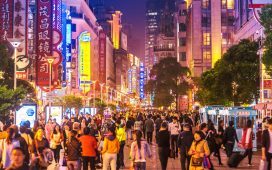Chinese provinces spent more than £42.8bn on tackling Covid-19 in 2022, according to data released by local governments, with the figure expected to rise as the huge cost of the pandemic hits the world’s second-largest economy.
Although national statistics are not yet available, at least 20 of China’s 31 provinces have published figures on how much money they spent on measures to control the pandemic.
China abandoned its zero-Covid policy in December. It is now trying to revive the sagging economy, which grew by just 3% in 2022, down from 8.4% in 2021, according to official statistics.
Different provinces measure their Covid-19 expenditures in different ways. Some include spending at all levels of government, while others only include provincial-level spending.
But according to the published data, the southern province of Guangdong, which is home to 127 million people and is China’s largest provincial economy, was the biggest spender. In 2022 it spent 71.1bn yuan (£8.6bn) on measures such as vaccination, testing and emergency benefits for people affected by the pandemic – an increase of more than 50% on the previous year. That spending equated to about 0.6% of the province’s gross domestic product in 2022. Before the pandemic, China spent about 5% of its GDP a year on healthcare.
Beijing spent 26.4bn yuan, mainly on epidemic control and prevention, the equivalent of about 111% of the city’s healthcare budget for last year. Shanghai, the country’s financial hub, spent 16.8bn yuan on similar Covid-prevention measures, including the construction of temporary hospitals. The two months of total lockdown in Shanghai hit the city’s economy, which contracted by 0.2% in 2022.
Since abandoning zero-Covid, China’s government has introduced various measures to try and stimulate economic growth. On 8 January, it reopened its borders for international travel, abandoning quarantine requirements for inbound travellers. The government has also announced measures to make it easier for property companies to raise financing after investment in 2022 fell by 10%, the first decline since records began. The real estate industry accounted for nearly one-quarter of China’s GDP in 2021, but a crackdown on the sector last year hit the economy.
Public spending can now be redirected towards measures designed to boost the economy. Local governments have embarked on a hiring spree of civil servants, with a plan to increase recruitment by 16%. Economists at the US investment bank Goldman Sachs forecast China’s growth in 2023 will reach 6.5%, boosting global demand by 1%.
But for ordinary Chinese, the cost of Covid-19 remains high. In December, China’s National Health Commission stopped publishing data on daily cases, amid concerns about a huge rise in infections after the end of the zero-Covid policy. China has officially recorded around 80,000 Covid-19 deaths since December, which would be a far lower death rate than Hong Kong experienced in the first two months of its Omicron wave. Still, other indicators suggest that illnesses and deaths are much higher: hospitals and mortuaries are overcrowded, and doctors in many places have run short of Covid-19 medicines.
Additional research by Xiaoqian Zhu















